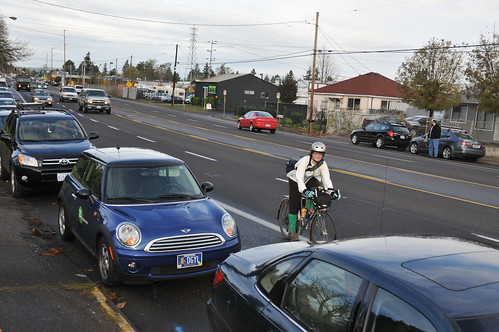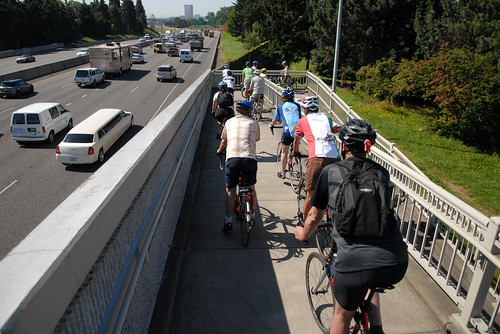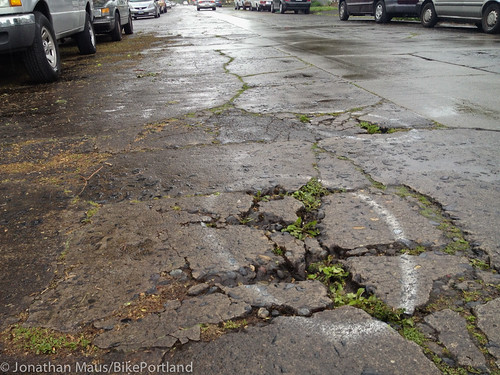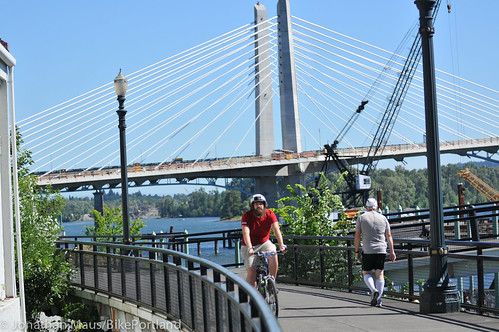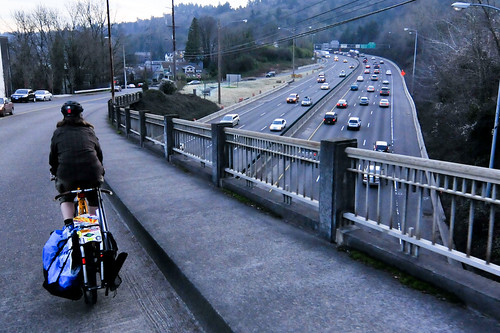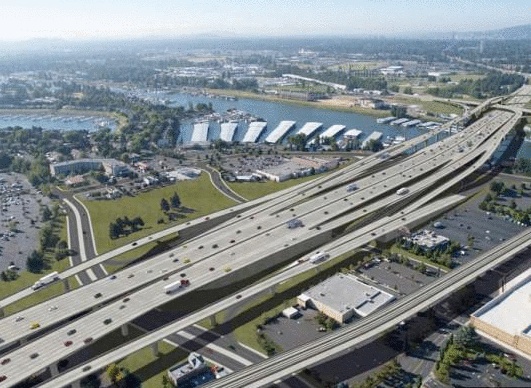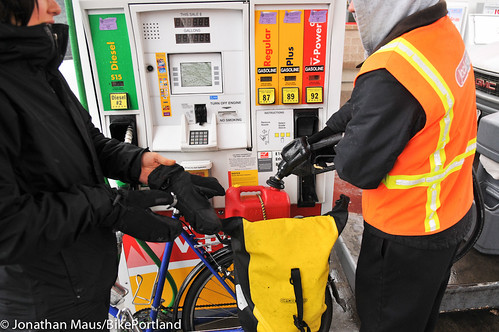This is a crosspost from City Observatory, the new think tank about urban policy led by Portland-based economist Joe Cortright. Many BikePortland readers will know Cortright as one of the loudest critics of the defunct Columbia River Crossing freeway expansion plan.
— by Joe Cortright
For the past several months, Portland’s City Council has been wrestling with various proposals to raise additional funds to pay for maintaining and improving city streets. After considering a range of ideas, including fees on households and businesses, a progressive income tax, and a kind of Rube Goldberg income tax pro-rated to average gasoline consumption, the council has apparently thrown up its hands on designing its own solution.
The plan now is for the street fee solution to be laid at the feet of Portland voters in the form of a civic multiple choice test: Do you want to pay for streets with a monthly household street fee, a higher gas tax, a property tax, an income tax or something else entirely?
Given voter antipathy of taxes of any kind, it’s likely that “none of the above” would win in a landslide if it’s included as an option on the ballot.
All of these options have their own merits and problems, and it’s doubtful that there is a majority consensus for any one of them. How, how much, and who pays for streets is a key issue for every city. From an urbanist and public finance perspective, and as a guide to thinking about which—if any—of these approaches Portland should adopt, here are my eight suggested rules for paying for streets:
1. Don’t tax houses to subsidize cars.
Despite mythology to the contrary, cars don’t come close to paying for the cost of the transportation system. The Tax Foundation estimates that nationally, only 30 percent of the cost of roads is covered by user fees like the gas tax. Not only do cars get a free ride when it comes to covering the cost of public services—unlike homes, they’re exempt from the property tax—but we tax houses and businesses to pay for car-related costs. Here are three quick examples: While half of storm runoff is from streets, driveways and parking lots, cars aren’t charged anything for stormwater—but houses are. A big share of the fire department’s calls involve responding to car crashes—and cars pay nothing toward fire department costs. Similarly, the police department spends a significant amount of its energy enforcing traffic laws—this cost is borne largely by property taxes—which houses pay, but cars don’t. If we need more money for streets, it ought to be charged on cars.
Adding a further charge on houses to subsidize car travel only worsens a situation in which those who don’t own cars subsidize those who do. One in seven Portland households doesn’t own a car, and because they generally have lower incomes than car owners, fees tied to housing redistribute income from the poor to the rich.
2. End socialism for private car storage in the public right of way.
Except for downtown and a few close-in neighborhoods, we allow cars to convert public property to private use for unlimited free car storage. Not asking those who use this public resource to contribute to the cost of its construction and upkeep makes no sense and ultimately subsidizes car ownership and driving. This subsidy makes traffic worse and unfortunately—but understandably—makes it harder and more expensive to build more housing in the city’s walkable, accessible neighborhoods. If, as parking expert Don Shoup has suggested, we asked those who use the streets for overnight car storage to pay for the privilege, we’d go a long way in reducing the city’s transportation budget shortfall—plus, we’d make the city more livable. We should learn from the city’s success in reforming parking for people with disabilities that getting the prices right makes the whole system work better.
3. Reward behavior that makes the transportation system work better for everyone.
Paying for the transportation system isn’t just about raising revenue—it should be about providing strong incentives for people to live, work and travel in ways that make the transportation system work better and make the city more livable. Those who bike, walk, use transit, and who don’t own cars (or own fewer cars) actually make the street system work better for the people who do own and use cars. We ought to structure our user fee system to encourage these car-free modes of transportation, and provide a financial reward to those who drive less. The problem with a flat-household fee or an income tax is it provides no incentive for people to change their behavior in a way that creates benefits for everyone.
Advertisement
4. Prioritize maintenance.
There’s a very strong argument that we shouldn’t let streets deteriorate to the point where they require costly replacement. Filling potholes and periodically re-surfacing existing streets to protect the huge investment we’ve already made should always be the top priority. Sadly, this kind of routine maintenance takes a back seat to politically sexier proposals to expand capacity. We need an ironclad “fix it first” philosophy. Also, we need to guard against “scope creep” in maintenance. There’s a tendency, once a “repair” project gets moving, to opt for the most expensive solution (see bridges: Sellwood, Columbia River Crossing). That’s great if your project gets funded, but a few gold-plated replacements drain money that could produce much more benefit if spread widely. We need to insist on lean, cost-effective maintenance.
5. Don’t play “bait and switch” by bonding revenue to pay for shiny, big projects.
There’s an unfortunate and growing tendency for those in the transportation world to play bait-and-switch with maintenance needs. They’ll tell us about the big maintenance backlog to justify tax and fee increases. Then they bond two or three decades worth of future revenue to pay for a shiny new project; the Sellwood Bridge and the local share of the Portland-Milwaukie light rail have been funded largely by tying up the increase in state gas tax revenue, vehicle registration fees, and flexible federal funds for the next two decades. The state, which routinely financed construction on a pay-as-you-go basis, has also maxed out its credit card: in 2002 ODOT spent less than 2% of its state revenue on debt service; today, it spends 35%. Now it is pleading poverty on highway maintenance. Politically, this makes a huge amount of sense. You get to build the projects today, and pass the costs into the future. Unfortunately, in practice it leads to a few gold-plated projects now, while jeopardizing the financial viability of the transportation system in the long run.
6. Promote fairness through the “user pays” principle.
We all want the system to be “fair.” In the case of general taxes, we often put a priority on progressivity—that taxes ought to be geared toward ability to pay. But for something like transportation (as with water rates, sewer rates, or parking meter charges), fairness is best achieved by tying the cost to the amount of use, or what economists call the “benefit principle.” Charges tied to use are fair for two important reasons: higher income people tend to use (in this case, drive) more than others, and therefore will end up paying more. Also, charges tied to use enable people to lower the amount they pay by changing their behavior.
7. Don’t buy the phony safety card.
We’ll hear all about the need to spend money to make our streets safer. The safety argument is an all-purpose smokescreen to justify almost any expenditure, no matter how distantly related to safety. (Ostensibly, the $3.5 billion Columbia River Crossing project was justified as a “safety” project, even though the I-5 bridge had a lower crash rate than the Fremont Bridge). Here’s the key fact of street safety: Smaller, slower streets are safer. Metro’s region-wide analysis of crash data showed that fast-moving, multi-lane arterials are by far the most dangerous streets in the region for cars, cyclists, and pedestrians. The more we get people out of cars, the more crashes and injuries decline. The most effective thing we can do to improve safety turns out to be the cheapest: implement features that slow and calm traffic, and make walking, cycling, and transit more attractive.
Commissioner Steve Novick points out correctly that his proposal contains a specific list of laudable safety projects that he proposes undertaking with street fee proceeds if his proposal is adopted. These projects don’t fall into the “phony safety” category outlined above. Still, voters should consider two other things. First, while the proposed list is a good one, it is “preliminary and subject to change” and isn’t binding on future city commissions, and the “safety” category is an elastic one. Safety projects are defined as those that “reduce the likelihood of a person being killed or injured and address the perception of risk.” Second, transportation money is very fungible. Its always possible to re-arrange the budget to tell someone that this “new” money is only being used for good purposes. The larger question is the overall priorities for the entire transportation budget. If safety spending out of current revenues is reduced, the net gain could be less than advertised.
8. Don’t write off the gas tax yet.
There’s a widely repeated shibboleth that more fuel-efficient vehicles have made the gas tax obsolete. Despite its shortcomings as a revenue source—chiefly that it bears no relationship to the time of day or roadway that drivers use—there’s nothing wrong with the gas tax as a way to finance street maintenance that a higher tax rate wouldn’t solve. While other methods like a vehicle-miles-traveled fee make a lot of sense, the reason they’re popular with the transportation crowd is because they would be set high enough to raise more money. And there’s the rub: people are opposed to the gas tax not because of what is taxed, but because of how much they have to pay. As an incremental solution to our maintenance funding shortfall, there’s a lot to like about a higher gas tax: it requires no new administrative structure, it’s crudely proportionate to use, and it provides some incentives for better use of streets. So when very serious people gravely intone that the gas tax is “obsolete” or “politically impossible”—you should know what they’re really saying is that people simply don’t want to pay more for streets.
Transportation and urban livability are closely intertwined. Over the past few decades it has become apparent that building our cities to cater to the needs of car traffic have produced lower levels of livability. There are good reasons to believe that throwing more money at the existing system of building and operating streets will do little to make city life better. How we choose to pay for our street system can play an important role in shaping the future of our city. As Portlanders weigh the different proposals for a street fee in the coming months, they should keep that thought at the top of their minds.
Joe Cortright is an economist and director of City Observatory, an urban-focused think tank supported by Knight Foundation and based in Portland, Oregon.



